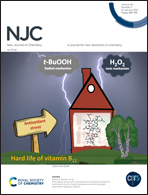Low-cost air-stable perovskite solar cells by incorporating inorganic materials
Abstract
Herein, we demonstrate a new fabrication strategy for low-cost and stable-operation perovskite solar cells (PSCs) suitable for commercialization. This is performed by fabrication of the device under ambient conditions using a Cs0.05(MA0.17FA0.83)0.95Pb(Br0.17I0.83)3 formulation as the mixed cation and halide (MCH) perovskite and CuInS2 (CIS) as the inorganic hole transporting layer. The deposited MCH perovskite with uniform, compact and smooth microstructure containing equiaxed large grains showed excellent thermal and structural stability under intense conditions at 85 °C for 2 h in humid air (i.e., 45% relative humidity). Moreover, it had higher phosphorescence emission, absorption and bandgap energy than the conventional MAPbI3 due to efficient conversion of PbI2 to the perovskite compound, as further confirmed by XRD analysis. Photovoltaic measurements under operational conditions revealed that the MCH-based PSC showed a 27% higher photoconversion efficiency compared with the control device composed of MAPbI3 caused by less charge recombination. The CIS-based MCH device aged for 30 days at 25 °C and 40% humidity retained 91% of the maximum efficiency with a low standard deviation of all photovoltaic parameters, indicating excellent potential for industrialization.



 Please wait while we load your content...
Please wait while we load your content...